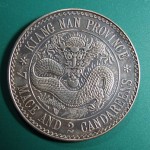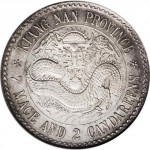The first modern, machine-struck silver coinage in China began in Guangdong in 1889. The new currency gaining in popularity, other provinces started to issue silver dollar coins. The Jiang Nan province (江南) was an early adopter and issued its first complete set of silver coins in 1897. This early set was minted in low quantities, with an original design which was quickly replaced by a more common one during the next two years. That makes the 1897 Kiangnan silver dollar a valued addition to a chinese dragon dollars collection. Sadly, the popularity of this coin amongst collectors made it a choice target for counterfeiters.
I recently saw a new kind of fake Lao Kiangnan coin floating around on online auction websites. It can easily be spotted by the little bumps around the rosette at the left of the dragon, and inside its coiled tail, as seen below.
Aside of the bumps, the coin is well struck and much more convincing than the usual crude forgeries found on these kind of websites. For comparison, here is what a real Lao Kiangnan looks like:
Any bumps on a machine struck coin should immediately raise suspicion; they are usually artifacts appearing during the process of casting. In this case, the coin is visibly struck, but most likely using a cast die – the bumps are the imprint of tiny bubbles trapped between the mold and the metal during the casting.

